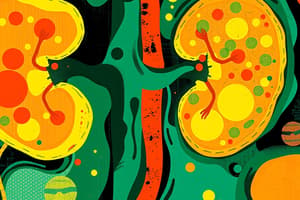Podcast
Questions and Answers
The Acetest tablet test is used to detect glucose in urine.
The Acetest tablet test is used to detect glucose in urine.
False (B)
Ketone testing with sodium nitroprusside involves using reagent strips.
Ketone testing with sodium nitroprusside involves using reagent strips.
False (B)
The introduction of reagent strips has made chemical screening of urine a slow procedure.
The introduction of reagent strips has made chemical screening of urine a slow procedure.
False (B)
The colors generated in the chemical examination of urine with reagent strips are compared against a generic color chart.
The colors generated in the chemical examination of urine with reagent strips are compared against a generic color chart.
Touching the chemical pads of the reagent strip with your fingers is recommended during the testing process.
Touching the chemical pads of the reagent strip with your fingers is recommended during the testing process.
Bilirubin is not one of the types of reactions that can be determined simultaneously using reagent strips.
Bilirubin is not one of the types of reactions that can be determined simultaneously using reagent strips.
Running positive control and negative control is a recommended practice during the chemical examination of urine with reagent strips.
Running positive control and negative control is a recommended practice during the chemical examination of urine with reagent strips.
Excess urine should be removed by blotting the edge of the strip into an absorbent pad.
Excess urine should be removed by blotting the edge of the strip into an absorbent pad.
The Acetest tablet test should be performed every 24 hours during the testing process.
The Acetest tablet test should be performed every 24 hours during the testing process.
The Etones Principle is a key aspect in the chemical examination of urine.
The Etones Principle is a key aspect in the chemical examination of urine.
Flashcards are hidden until you start studying
Study Notes
Urine Glucose Testing
- Reagent strips are used to detect glucose in urine, utilizing a double sequential enzymatic reaction involving two enzymes: glucose oxidase and peroxidase.
- The reagent strip contains a mixture of glucose oxidase, peroxidase, chromogen (indicator), and buffer.
- The enzyme reaction produces a color change, which is compared to a color chart to determine the glucose level.
Quality Control for Reagent Strips
- Manual quality control methods can be used when questionable results are obtained or when a new bottle is opened.
- Precautions for using reagent strips include:
- Mixing the urine specimen thoroughly
- Not allowing the strip to remain in the urine for extended periods
- Blotting the edge of the strip after dripping to prevent run-over
- Comparing color reactions with the color charts horizontally
- Following specific timing for each pad
- Using a good light source
- Not interchanging reagents strips and color charts from different manufacturers
- Allowing refrigerated specimens to return to room temperature before using reagent strips
- Protecting reagent strips from deterioration caused by moisture, volatile chemicals, heat, and light
- Storing reagent strips tightly closed at room temperature below 30°C and not refrigerated
- Not using past the expiration date
Reaction Interferences
- False positive results can occur due to:
- Hydrogen peroxide
- Urine container contaminated with detergents
- False negative results can occur due to:
- Ascorbic acid
- High level of ketones
- High specific gravity of urine
- Low temperature
- Prolonged standing of urine
Copper Reduction Tests for Glucose
- The copper reduction test relies on the ability of glucose and other reducing substances to reduce copper sulfate to cuprous oxide in the presence of alkali and heat.
- Tests that utilize this principle include:
- Benedict's Test
- Clinitest Tablet
Urine Glucose Clinical Significance
- Hyperglycemia is associated with:
- Diabetes Mellitus
- Impaired function of insulin
- Pancreatitis
- Decreased levels of insulin
- Pancreatic cancer
- Increased glucagon and somatostatin
- Acromegaly
- Increased growth hormone
- Increased cortisol
- Increased epinephrine
- During pregnancy
- Cushing Syndrome
- Pheochromocytoma
- CNS damage
- Stress
- Gestational Diabetes
- Renal associations (defects in kidney's tubular reabsorption) include:
- Fanconi Syndrome
- Tubular Disorders
- Advanced Renal Disease
- Osteomalacia
- Vitamin D deficit (softening of bone)
Chemical Examination of Urine
- Chemical examination of urine validates the physical aspect of urine analysis.
- Reagent strips are a sensitive and rapid procedure for chemical screening of urine.
- The reagent strip technique involves:
- Dipping the reagent strip briefly into a well-mixed urine at room temperature
- Removing excess urine by touching the edge of the strip to the container upon withdrawal
- Blotting the edge of the strip into an absorbent pad
- Waiting for the specified amount of time
- Comparing the color reaction of each pad to the manufacturer's color chart
Studying That Suits You
Use AI to generate personalized quizzes and flashcards to suit your learning preferences.




